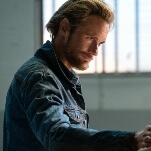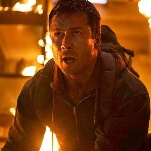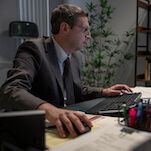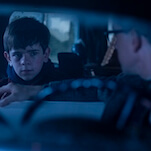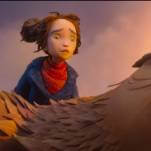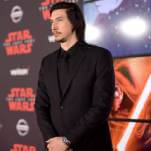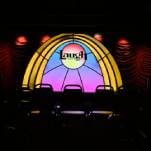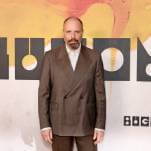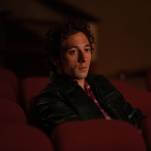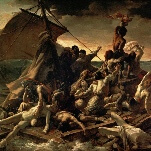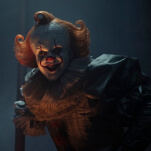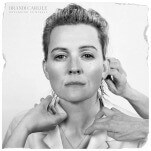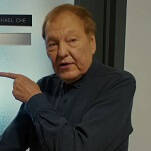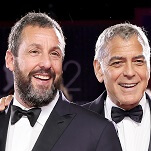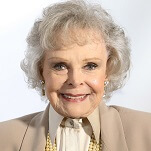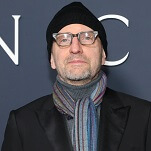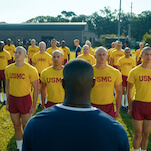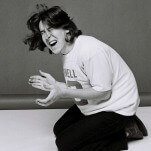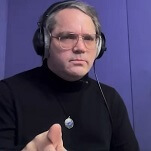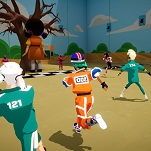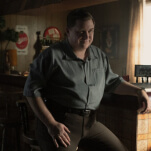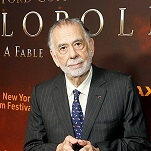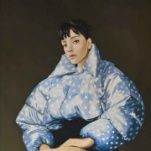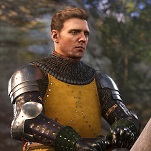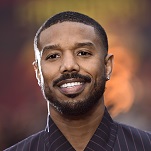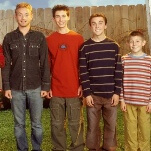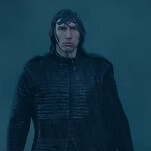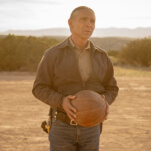Barry Sonnenfeld began his career as the cinematographer of choice for style-conscious directors like the Coen brothers and Danny DeVito, and has continued to work in broad strokes while directing his own blockbuster comedy hits, such as The Addams Family, Get Shorty, and Men In Black. After a decadelong hiatus, the Men In Black franchise is back, with Sonnenfeld at the helm. In the film, the titular government alien-fighters deal with a temporal anomaly that sees Agent K (Tommy Lee Jones) erased, forcing Agent J (Will Smith) to head back to the ’60s and work the case with a younger version of K (Josh Brolin). Sonnenfeld spoke with The A.V. Club about the new film, what he tried to do differently with 3-D in Men In Black 3, and the movie’s fantastic supporting performance by Michael Stuhlbarg.
AVC: Whenever you deal with time travel, you get science-fiction fans who scrutinize to make sure every element is chronologically consistent. Did you worry about that?
BS: We needed to make sure we set up the rules of time travel and what our guys were trying to accomplish, so the audience never got confused or lost or stopped paying attention to the movie. But that was the extent of it, really.
AVC: Did you find it easy to step back into the Men In Black world after so much time away?
BS: Well, what’s great is that Will and Tommy and I get along really great, so even though we hadn’t seen each other for 10 years, it was like we hadn’t seen each other for a long weekend. The issue then was just making sure that the chemistry between Will and Josh Brolin was going to be as good and as strong as what we had with Will and Tommy, because if that didn’t work, then the movie’s over. If the audience is watching the middle act and most of the last act going, “Well, this doesn’t work. This is no fun. This isn’t what I came to see, this isn’t Will and Tommy,” then really, that’s the single biggest way you could ruin the movie. Luckily, Will and Josh had the same chemistry both on- and offscreen that Will and Tommy have.
AVC: Did Jones have any issue with being out for roughly two-thirds of the movie?
BS: I don’t think so. I think Tommy would’ve loved to have been in the whole movie, because he really likes working with Will and me and has a good time, but I think he understood that this was a way of making a Men In Black 3 that seemed fresh. It was the only way for us to make a movie that didn’t just seem like, “A new alien has come to earth, threatens it, our guys solve a crime, end of story.” He understood that the nature of the entire story required this, and I think he thinks we made a great film.
AVC: Josh Brolin and Tommy Lee Jones have worked together before, but did they spend any time together on this set?
BS: No. Josh watched the first two Men In Blacks, especially the first one, over and over, and had an MP3 player on the set where he listened to Tommy’s dialogue from the first movie. Tommy has a very specific lilt and structure to his sentences; there’s a lot of movement in it. But they didn’t have discussions about how to play the part, and Josh didn’t really watch him on the set, because Josh kind of plays a different character. Josh has the same mannerisms and voice as Tommy Lee Jones, but he plays a much younger, more optimistic, more romantic version of K. You’d have to ask Josh, but I don’t think Josh would’ve gotten much out of being on the set. Also, sets are so inefficient. It takes so much time to set up shots and all that. You can get a lot more done just listening to the movies and learning your lines.
AVC: You’re known for your dynamic visual style, and in this film, you add 3-D to that. What was the adjustment like for adding a third dimension to the image?
BS: You know, for me, there was absolutely no adjustment in shooting in 3-D, because the way I shoot in 2-D feels like I shoot in 3-D. If you look at Raising Arizona, which I was the cinematographer on, or Throw Momma From The Train, or what I did as a director in the first Men In Black or The Addams Family, I think those could be turned into 3-D movies without any adjustment. I suggested to Sony that I wanted to release the movie in 3-D when we started to shoot. We shot a lot of tests on a lot of 3-D rigs, and they were all too big and cumbersome, and they don’t let you shoot film, you have to shoot digitally. So at the same time, I shot exactly the same shots for the test, but shot them in 2-D and converted them. The conversion process for me worked way better than shooting natively, and gave me much more control of depth in post. So it’s actually why I think this movie looks better converted than if I had shot in 3-D, because it doesn’t give you a headache. I can very subtly move around where the depth is.
And if you look at the film—actually, a lot of the film, because of the very wide lenses I use, the audience almost feels like they’re in the scene with the actors. It’s a little bit more immersive. What I’ve had a problem with in other 3-D movies that I’ve seen, even beautiful-looking 3-D movies like Avatar and Hugo, is that they put a lot of the depth behind the screen and put the convergence at the screen. I find that actually more distancing for the audience than if they’d actually released it in 2-D. What we did with convergence and depth is bring it much closer to the audience. So I loved the process—loved it—and what I’ve always visualized in 3-D was very easy for me.
AVC: It does seem as though the screen is kind of out toward the audience—like if you look at the little curtain below the screen, it seems to be behind the screen.
BS: Yeah, the actors are actually in front of where the curtain was, a little bit. Yes, that was very intentional, and I’m really proud of it.
AVC: Are you planning to shoot in 3-D from now on?
BS: You know what, it depends on the movie. If I were doing Men In Black 4 or a movie that had that kind of visual style, absolutely. I truly love it. If I were doing Get Shorty 2, I probably wouldn’t.
AVC: Men In Black II has a Roman numeral; Men In Black 3 does not. Is there a reason for that?
BS: I’m not in the marketing and exhibition department; I think the reason we went Arabic for number three is to make it seem more like the “3” in 3-D. I would guess that’s the reason, but it’s conjecture on my part.
AVC: Michael Stuhlbarg gives a funny, soulful performance in this film as an alien who exists in an infinite number of timelines simultaneously. Were you involved at all in casting him? And did he come to the set with that performance fully formed?
BS: I had everything to do with casting him. He auditioned two or three times for the role. Actually, my first choice was Marty Scorsese, but he was working. And then Michael came in, and I thought his performance in A Serious Man was brilliant; it was my favorite performance of that year. So Michael read it several times, and we tried different ways of doing it, but I thought he was perfection. He’s also my favorite alien in the movie, because one of the things that makes Men In Black successful when it’s working is that yes, there are villain aliens, and there are creepy aliens, and there are little aliens, and there are worm aliens, and there are cute aliens, but my favorite aliens are the ones that are somehow kind of mystical or magical. You know, in the first one, there was that one that lived inside the head of that other guy—at the morgue, you see Mike Nussbaum’s head open up, and you see this little green guy that’s been driving this human you’ve been watching.
In this movie, I love the concept of… it’s not called this in the script, but I always call it “the quantum mechanic.” Michael came to the process already with a lot of great ideas, and was very sort of moving and emotional and warm, and what I added to that was, I wanted Michael to talk faster than he was talking. It was hard for me to get him to talk fast enough, because I think he felt it might hurt his performance, but I felt it would help his performance. About a week into shooting, I said, “So Michael, you know you’re a quantum mechanic,” and he said, “Yes.” And I said, “And you know you can see all possibilities that are happening at once,” and he said, “Yes, every possibility’s happening at once, and it’s not until it happens that it coalesces that way.” And I said, “Yes, and he knows if he talks too slowly, whatever he’s talking about, that version could change by the time he finishes his sentence, which is why he talks really quickly—so he can get it out before a different version of reality happens.” That’s why I had initially thought of Scorsese, because Scorsese has that rapid-fire talk. And Michael immediately got it, loved it, and then ran with it.
So that was my acting contribution to Griffin. It was Michael’s idea to have the blue contacts. It was my idea to have him wear way too many layers of clothing, ’cause I feel that on his planet, 97 degrees Fahrenheit and 80 percent humidity is super-cold. Stuff like that. It was a real collaboration, and I think he’s both moving and funny, which is very hard to do.
